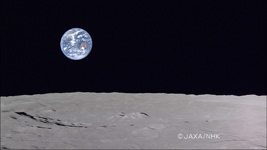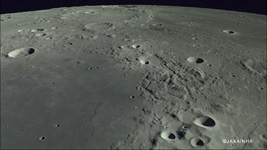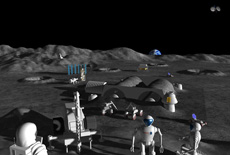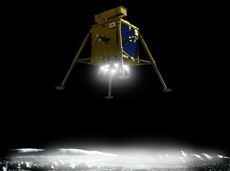Q. How is KAGUYA perceived outside Japan?

The lunar surface and the Earth, imaged by KAGUYA's high-definition camera
Scientists around the world are excited about KAGUYA because no other lunar explorer has carried as many as 14 scientific instruments, nor obtained such a great volume of high-resolution data. We have been invited to present our findings at many international conferences, including the annual Lunar and Planetary Science Conference in the United States. Prior to launch, KAGUYA did not get much attention at the conference, but since last year we have been given session time, and our sessions have been very well attended. The moving images from the high-definition camera are especially popular – audiences always find them fascinating. This shows me that people are really curious about the Moon.
KAGUYA's data will be released to scientists around the world starting this November. We hope to provide user-friendly data that will be broadly used.
KAGUYA's data will be released to scientists around the world starting this November. We hope to provide user-friendly data that will be broadly used.
Q. Could you tell us about KAGUYA's current status and upcoming plan?

Vicinity of Grimaldi, imaged by KAGUYA's high-definition camera
KAGUYA conducted global mapping of the Moon for about 10 months, starting near the end of 2007, and the original observation plan is now complete. Since November 2008, the spacecraft has been mainly carrying out spectroscopic measurement of gamma rays to collect data that were missing from previous measurements. And on February 1, we started a new operation plan by lowering the spacecraft's orbit from an altitude of 100 kilometers to 50 kilometers. At 50 kilometers, observation precision can be increased by a factor of eight, so there may be more discoveries in KAGUYA's future. If enough fuel is still left after several months of observation at that altitude, we are even thinking of lowering KAGUYA's orbit further over the South Pole, to observe magnetic fields. A lot of fuel is required to keep lower orbit, so at this stage I don't know how much will remain. KAGUYA will use up all its fuel before summer and impact the lunar surface. It will be able to continue observation until the moment it hits the ground, and we have some ideas for its final observation, such as looking at the topography of a certain area. No matter what it will be, we will adjust the spacecraft's orbit to make it land in a designated area on the nearside, visible from Earth, so that we will be able to watch the illumination of its impact on the surface. We would like many people to see KAGUYA off at its very last moment.
The relay satellite Okina, one of the two subsatellites, already impacted on the farside on February 12. The other one, Ouna (VRAD satellite), is still in orbit. It will be several years until it impacts the Moon.
The relay satellite Okina, one of the two subsatellites, already impacted on the farside on February 12. The other one, Ouna (VRAD satellite), is still in orbit. It will be several years until it impacts the Moon.
Q. What kind of outcomes are now anticipated for KAGUYA?
I am looking forward to obtaining new types of results from the gamma ray data and the upcoming magnetic field observations from a lower altitude.
KAGUYA scientists are responsible for both the operation of the spacecraft and data analysis at the same time. Although the global mapping is complete, data analysis has just begun, and only the most basic data have been analyzed. The first results have been published in academic journals, and more interesting papers will soon be on their way.
KAGUYA scientists are responsible for both the operation of the spacecraft and data analysis at the same time. Although the global mapping is complete, data analysis has just begun, and only the most basic data have been analyzed. The first results have been published in academic journals, and more interesting papers will soon be on their way.
Q. Apart from KAGUYA, what types of lunar exploration is in progress in Japan and elsewhere?

U.S. Lunar Reconnaissance Orbiter (courtesy: NASA)
In October 2007, about a month after KAGUYA, China launched its first lunar orbiter, Chang'e-1. It observed mineral and element distribution on the Moon at an altitude of about 200 kilometers. After surpassing the mission's one-year life expectancy, it continued observations from lower altitudes, but finally, running out fuel, it ended its mission and impacted the Moon on March 1. India also launched a lunar orbiter, Chandrayaan-1, in October 2008, and has started observation of lunar minerals and topography with 11 onboard scientific instruments, some of which were developed by NASA and ESA (the European Space Agency). I've heard that Chandrayaan-1 has dropped its Moon Impact Probe somewhere near the South Pole. Its purpose is to observe the lunar surface from a close distance, and I am very much looking forward to the results. And this May, the United States is going to launch the Lunar Reconnaissance Orbiter (LRO). Its objectives are to map the Moon in detail from a 50-kilometer orbit; to monitor lunar resources and look for evidence of water; and to conduct investigation for future human lunar exploration and the construction of a lunar base. The LRO mission is also scheduled to launch the Lunar Crater Observation and Sensing Satellite (LCROSS). It will impact in a crater near the polar region to create an ejecta plume, and observe its properties.
In Japan, the next lunar exploration mission after KAGUYA is under consideration. And China and India are planning to launch new versions of their probes – Chang'e-2 in 2010, and Chandrayaan-2 – sometime between 2010 and 2012. Thus, with the success of their own first lunar missions, these countries are planning their next steps. In a sense, I think that these Asian countries – Japan, China, and India – have launched lunar exploration in a new direction.
In Japan, the next lunar exploration mission after KAGUYA is under consideration. And China and India are planning to launch new versions of their probes – Chang'e-2 in 2010, and Chandrayaan-2 – sometime between 2010 and 2012. Thus, with the success of their own first lunar missions, these countries are planning their next steps. In a sense, I think that these Asian countries – Japan, China, and India – have launched lunar exploration in a new direction.
Q. How do you think KAGUYA's results are going to be used in future lunar exploration missions?

Lunar base (artist rendering)
KAGUYA provides fundamental data about the Moon. I think future explorers will land on the surface to carry out observations, and bring many more discoveries. For this to happen, we need to analyze KAGUYA's data in detail to choose the best landing location, and we also need to develop new lander technology. I think KAGUYA's data on lunar gravity will be very useful for this venture.
In addition, lunar exploration will lead to the construction of a lunar base, and human exploration of Mars. For humans to live at a lunar base, it is important to secure resources, including water. I hope that we can help find solutions to these issues on future missions.
In addition, lunar exploration will lead to the construction of a lunar base, and human exploration of Mars. For humans to live at a lunar base, it is important to secure resources, including water. I hope that we can help find solutions to these issues on future missions.
Q. What are your expectations for future lunar exploration?

KAGUYA's successor, SELENE 2, is under consideration
I expect it to provide scientific information for us to better understand the Moon. As we start seeing the whole picture, we will want to investigate specific areas more closely. In recent years, geoscience, which studies the Earth, has developed into Earth/planetary science, which also includes the solar system. I would like lunar science to develop the same way, expanding its scope to explain the Moon's relationship with the Earth, and with the solar system.
I also hope to establish Japan's characteristic strengths, which researchers and scientists around the world can depend on. To earn their trust, we must make the KAGUYA mission successful. KAGUYA's goal is to determine the materials and structure of the Moon. Our priority is to achieve this with KAGUYA's global mapping, and then I will look forward to what comes next.
I also hope to establish Japan's characteristic strengths, which researchers and scientists around the world can depend on. To earn their trust, we must make the KAGUYA mission successful. KAGUYA's goal is to determine the materials and structure of the Moon. Our priority is to achieve this with KAGUYA's global mapping, and then I will look forward to what comes next.
Manabu Kato
Professor, Department of Planetary Science, Institute of Space and Astronautical Science (ISAS)/JAXA
Dr. Kato received his Ph.D. in 1976 from the Graduate School of Science at Nagoya University. After working as a research associate and an associate professor at the School of Science at the university, he joined ISAS (now part of JAXA) in 1997, and worked on the development of an X-ray fluorescence spectrometer for observing element distribution on planets. He was responsible for the X-ray fluorescence spectrometers on the asteroid explorer Hayabusa, launched in 2003, and the lunar orbiter KAGUYA, launched in 2007. He is also science manager for KAGUYA. His specialty is planetary science.
Professor, Department of Planetary Science, Institute of Space and Astronautical Science (ISAS)/JAXA
Dr. Kato received his Ph.D. in 1976 from the Graduate School of Science at Nagoya University. After working as a research associate and an associate professor at the School of Science at the university, he joined ISAS (now part of JAXA) in 1997, and worked on the development of an X-ray fluorescence spectrometer for observing element distribution on planets. He was responsible for the X-ray fluorescence spectrometers on the asteroid explorer Hayabusa, launched in 2003, and the lunar orbiter KAGUYA, launched in 2007. He is also science manager for KAGUYA. His specialty is planetary science.
KAGUYA's Major Scientific Results So Far
KAGUYA: Probing Lunar Science
The First Global Stereo-Imaging of the Moon
Studying the Gravity and Topography of the Moon
A New Era of Lunar Exploration
KAGUYA: Probing Lunar Science
The First Global Stereo-Imaging of the Moon
Studying the Gravity and Topography of the Moon
A New Era of Lunar Exploration